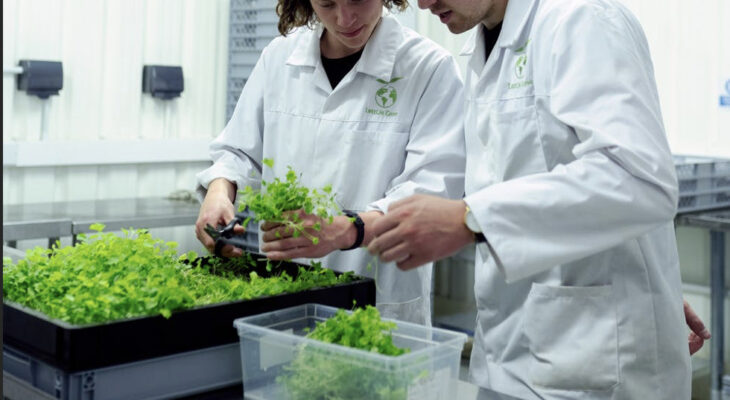Whereas synthetic intelligence (AI) seemed to be science fiction till not too long ago, numerous organizations around the globe at the moment are learning methods to include this know-how into each day life. AI operates by analyzing monumental quantities of knowledge, deciphering patterns within the information, and changing these interpretations into actions just like these of a human. Scientists have used it to construct self-driving automobiles and chess-playing computer systems, but it surely has additionally been utilized to agriculture. AI can encourage more practical farming strategies to sort out world warming, however provided that its progress is tightly regulated.
Local weather change continues to pose a risk to each space of our life, together with meals manufacturing. In response to a examine from Wageningen College, local weather change will really diminish soil moisture in areas across the equator whereas leaving northern international locations largely unaffected. Decrease crop yields are obvious proof of the affect of those altered progress situations on our meals manufacturing.
The discount of meals manufacturing has a very unfavorable affect on underdeveloped international locations. Local weather change leads to a lack of 35 trillion consumable meals energy yearly, placing poorer international locations at an obstacle as a result of they can’t afford to import meals. Because of this, meals insecurity is on the rise. Rising sea ranges solely exacerbate the issue. Sea ranges are anticipated to extend by one meter by 2100, posing an issue for coastal growers whose crops can not stay in overly saline water.
Agriculture is each a sufferer and a driver of world warming. Agriculture is part of a vicious cycle wherein farming causes world warming. This creates a vicious cycle the place world warming causes agricultural manufacturing to endure. Deforestation happens because of eradicating the wildlife in land that has been put aside for agriculture, which contributes to 40% of worldwide methane era. Because of this, to fight local weather change, we should observe reforestation.
How can we obtain this, and what’s the path in the direction of environment friendly, environmentally acutely aware farming?
That is the place synthetic intelligence (AI) comes into play. Farmers make the most of AI for precision agriculture, which permits them to observe crop moisture, soil composition, and temperature in rising areas. This enables them to spice up yields by studying methods to care for his or her crops and calculating the optimum quantity of water or fertilizer to make use of.
The usage of AI in agriculture has given rise to apps that give farmers recommendation on water administration, crop rotation, well timed harvesting, optimum planting, and pest assaults. We are able to forecast meteorological situations, management diet, and assess crop sustainability utilizing machine studying algorithms and images obtained by satellites and drones.
Precision farming is a technique of accelerating crop yields by using information inputs in exact quantities. Farmers can purchase a tailor-made plan for his or her farms utilizing AI software program. They’ll then meet the wants of our present and future worlds utilizing IoT and AI-driven options, similar to better meals manufacturing and profitability, with out depleting our pure sources.
Soil is likely one of the most important elements of the well being and growth of a plant. The soil’s diet determines the standard of the crop. Because of deforestation, soil high quality deteriorates with time, making it troublesome for farmers to find out which soil is right for which crop. With the assistance of AI, farmers at the moment are capable of monitor soil and crop high quality in real-time.
Moreover, by permitting people to develop meals in city locations, this know-how might scale back deforestation. One Israeli tech startup used AI algorithms to supply excellent gentle and water situations to develop crops in a container sufficiently small to be housed inside a house. The know-how may show particularly helpful in Latin American and Caribbean international locations, the place many of the inhabitants lives in cities. Moreover, rising meals in pre-existing metropolitan areas signifies that humanity might turn out to be much less reliant on deforestation to fulfill their meals wants.
Moreover, AI can help in figuring out and defending carbon sinks or forest areas that take up carbon dioxide from the environment. If these timber are usually not cleared, extra carbon dioxide might be launched into the sky. Moreover, synthetic intelligence is being created to detect and goal weeds in a discipline with the correct amount of herbicide, eradicating the necessity for farmers to disperse chemical substances throughout total fields and contaminate the surroundings. Some international locations have already begun to make use of AI of their agriculture practices.
Exterior of agriculture, AI could be utilized to scale back world warming. The know-how might observe how energy-efficient buildings are and control city warmth islands. City warmth islands are fashioned when warmth is absorbed by city constructing supplies similar to concrete and asphalt, main cities to turn out to be hotter than their environment. Because of this, folks rely extra closely on air con all through the day to remain cool, leading to elevated greenhouse fuel emissions from the power consumed. Offering data on the areas of those islands may help legislators in deciding what insurance policies to implement to reduce emissions and encourage extra environment friendly and environmentally-conscious metropolis planning.
Over time, air pollution ranges have risen dramatically, and weather conditions have turn out to be more and more unpredictable. Farmers have discovered it difficult to resolve the very best time to sow seeds resulting from local weather change, and that is the place AI comes into play as soon as extra. It’s easy to amass information into how climate, seasonal daylight, wind pace, and rain will have an effect on agricultural planting cycles utilizing synthetic intelligence. Farmers will have the ability to look at and plan when to plant their seeds utilizing climate predictions. A use-case for AI, on this case, can be IBM climate forecast. In a climate interruption, IBM climate forecast sends out notifications and provides built-in options to maximise crop yields, restrict environmental affect, and get monetary savings.
As talked about beforehand, crop yield could be improved utilizing real-time sensor information and visible analytics information from drones, due to AI and machine studying in agriculture. Drones can present real-time video surveillance and evaluation of agricultural progress patterns. Then again, sensible sensors can present data on moisture, fertilizer, and pure nutrient ranges. Moreover, drones are viable for acquiring information on how numerous fertilizers, irrigation patterns, and pesticide remedies enhance crop yields.
Together with drones, corporations utilizing synthetic intelligence are creating robots that may carry out quite a lot of farming duties. These robots might be taught to handle the unfold of weeds and to gather crops. They’ll even be taught methods to decide and bag crops. Reasonably than relying totally on people for labor, the purpose is to automate such guide operations and full them at a significantly sooner charge with extra vital volumes.
Whereas we now have mentioned the advantages of AI, we should additionally tackle the challenges.
When used incorrectly, AI can contribute to world warming. Knowledge storage and processing facilities that present digital providers like leisure and cloud computing now account for two% of world greenhouse fuel emissions. That is the aviation trade’s general contribution to air pollution. Because of the huge amount of knowledge that AI should analyze, coaching a single AI system emits 5 instances the emissions that a median automobile would generate throughout its lifetime, including to the already vital impact of laptop know-how on the surroundings.
Given these issues, we can not use AI as the one response to local weather change. Adaptive applied sciences might help alleviate the results of local weather change, however extra complete steps are wanted to make sure world meals safety within the face of rising temperatures. Earlier than investing in AI on a bigger scale, world leaders should consider the doable prices, the function of authorized establishments, and the environmental results of knowledge processing.
When used properly, the a number of advantages that AI provides actually outweigh the negatives. After all, each people and firms want to judge whether or not they can afford to put money into an environment friendly AI system that really protects the surroundings.
Within the hopes of serving to the underdogs reach positively impacting their group, Aquaponics AI powers the heroes of next-gen manufacturing with know-how and analysis to enhance their farms. Aquaponics AI can even join farmers with system designers and thought leaders within the trade. The workforce has related with the trade’s thought leaders and innovators to work and clear up meals insecurity by collaborating and increasing the observe of aquaponics globally.
For extra details about Aquaponics AI, click on right here.






